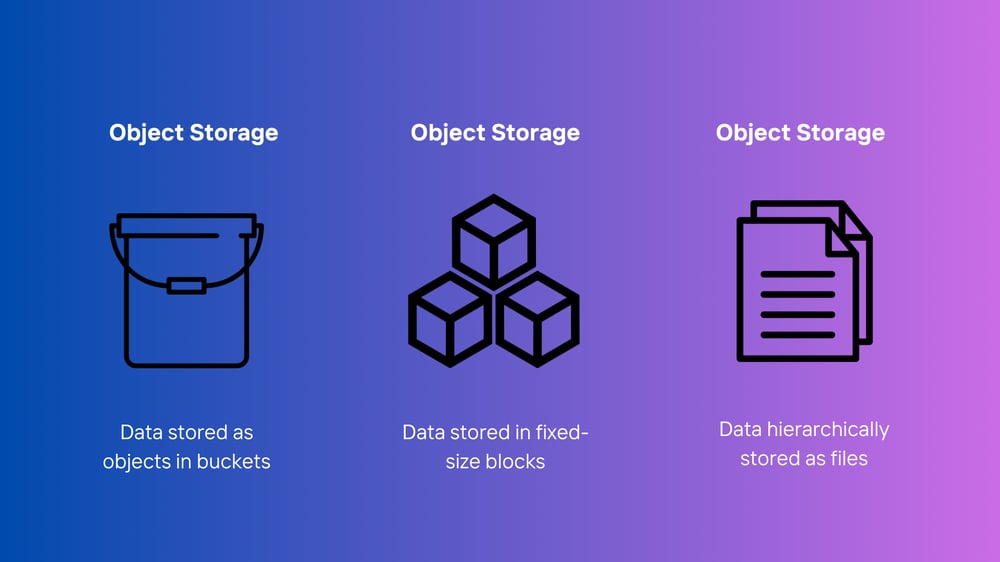Which Storage Solutions Fit Your Organisation Best? Here's Some Options to Help You Make an Informed Decision.
Discover a range of storage solutions designed to manage and optimise your data.
5 minute read

The amount of data generated by organisations is growing rapidly. According to a report by IDC, the global data sphere is expected to reach 175 zettabytes by 2025, with public sector organisations contributing significantly. This explosion of data presents unique challenges for IT professionals, who must manage not only the sheer volume but also complexities such as data sprawl, rising storage costs, and stringent security requirements.
Managing large volumes of data can be overwhelming, especially when it is scattered across different systems. This fragmentation makes it difficult to manage, secure, and access data efficiently, leading to inefficiencies, security risks, and compliance issues. This blog explores various storage solutions that can help manage and optimise your data storage, ensuring your organisation remains efficient, compliant, and secure.
The Impact of Data Overload on Organisations
Data overload is not just a storage issue; it’s a critical challenge that can have far-reaching effects on your organisation’s operations. When data is not managed properly, several significant problems can arise:
-
-
Inefficiencies: Data spread across various systems can make finding and accessing the right information time-consuming, slowing down operations and reducing productivity.
-
Increased Costs: Storing large volumes of data can be expensive, especially if outdated or inefficient storage solutions are used. As data continues to grow, so do the costs of maintaining and securing it.
-
Security and Compliance Challenges: Ensuring that data is stored securely and in compliance with regulatory requirements is a top priority for all organisations. However, data overload can make it difficult to maintain the necessary controls, increasing the risk of data breaches and compliance violations.
-
Strain on IT Resources: Managing large amounts of data requires significant IT resources. Without the right storage solutions, your IT team may find themselves overwhelmed, leading to delays in other critical projects.
-
Data overload is a risk that needs to be managed effectively. The key to overcoming this challenge lies in selecting the right storage solutions tailored to your organisation’s needs.
Understanding Different Types of Data Storage Solutions
When it comes to managing large volumes of data, not all storage solutions are created equal. Understanding the differences between the main types of data storage is crucial in making an informed decision:
-
-
Block Storage:
-
How it Works: Block storage divides data into fixed-sized blocks, each with a unique identifier. These blocks can be stored separately and reassembled by the storage system when accessed.
-
Use Cases: Block storage is ideal for high-performance applications that require fast access to data, such as databases, virtual machines, and transactional systems.
-
Advantages: High performance, low latency, and reliability make block storage ideal for mission-critical applications
-
-
File Storage:
-
How it Works: File storage organises data into a hierarchical structure of files and folders, similar to how documents are stored on a personal computer.
-
Use Cases: This type of storage is best suited for environments where data needs to be frequently accessed and updated, such as shared drives, media asset management, and project collaboration.
-
Advantages: Easy to use and manage, with a familiar structure that supports collaborative work.
-
-
Object Storage:
-
How it Works: Object storage manages data as objects, each containing the data itself, metadata, and a unique identifier. Unlike block and file storage, it does not use a hierarchical structure.
-
Use Cases: Object storage is highly scalable and cost-effective, making it ideal for storing large amounts of unstructured data, such as backups, archives, big data analytics, and cloud-native applications.
-
Advantages: Highly scalable and cost-efficient, with the ability to handle vast amounts of unstructured data.
-
-
To help you determine the best storage solution, consider the nature of your data, performance needs, budget constraints, and future growth expectations. A well-thought-out strategy will enable you to manage data more effectively and reduce the risk of overload.

The Role of S3 in Modern Data Storage
S3 (Simple Storage Service) has become a widely adopted standard in cloud storage due to its flexibility, scalability, and robust security features. It is used by many organisations to address the challenges of managing large volumes of data. Here’s why S3 is worth considering:
-
-
Scalability: S3 can scale up or down based on your needs, making it perfect for handling fluctuating amounts of data without significant upfront investment.
-
Durability and Security: With features like Object Lock, versioning, and encryption, S3 ensures that your data is protected against accidental deletions, corruption, and unauthorised access.
-
Versatility: S3 can be used for a variety of purposes, from backups and disaster recovery to data lakes and archiving.
-
However, while Amazon S3 is a popular choice, it can be cost-prohibitive for some organisations, as it charges not only for storage but also for data egress, ingress, and API calls, which can lead to unpredictable costs as data usage fluctuates. This pricing model can be particularly challenging for organisations with budget constraints.
Alternative S3-compatible storage solutions, such as Maple S3, offer the same benefits without the hidden fees. With Maple S3, you only pay a straightforward price per terabyte per month. This model eliminates the extra costs associated with egress, ingress, and API calls, providing organisations with predictable costs and peace of mind.
Integrating S3 into your existing infrastructure can help streamline data storage, improve accessibility, and reduce costs. By leveraging S3’s capabilities, organisations can better manage the complexities of large-scale data storage.
Best Practices for Managing Large Amounts of Data
Effectively managing large amounts of data requires a strategic approach. Here are some best practices to consider:
-
-
Data Categorisation: Start by categorising your data based on its importance, frequency of access, and regulatory requirements. This will help you decide where and how to store it.
-
Data Lifecycle Management: Implement lifecycle policies to automatically transition data between different storage classes based on its usage, helping to optimise costs and efficiency.
-
Automation: Use automation tools to handle routine data management tasks, such as backups and archiving, to reduce the burden on your IT team.
-
Regular Audits and Monitoring: Conduct regular audits to ensure that your storage solutions are performing optimally, and that data is stored in the most appropriate location.
-